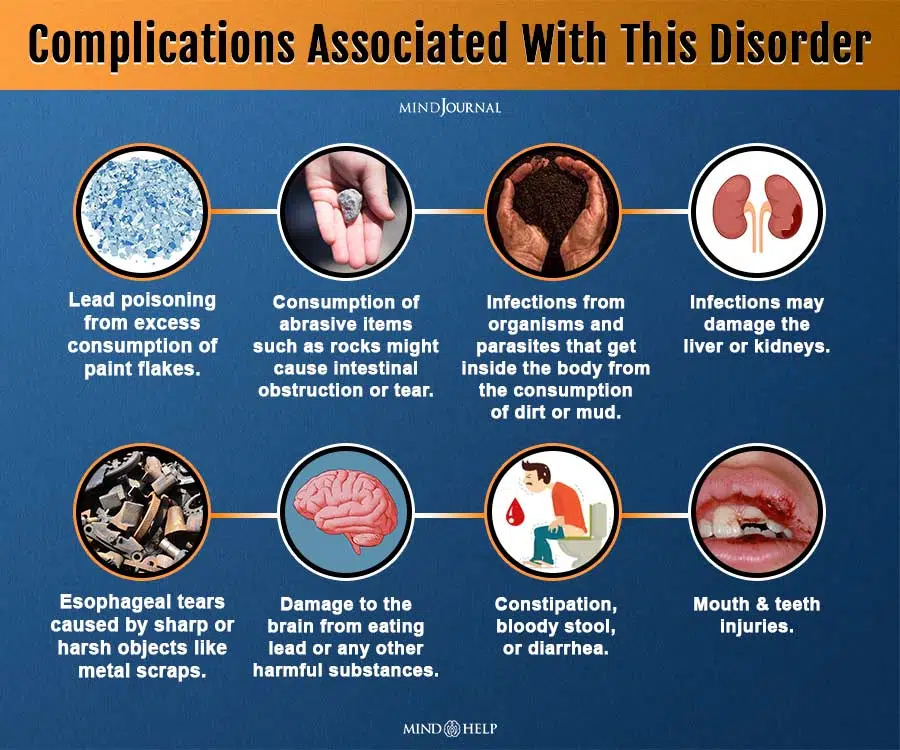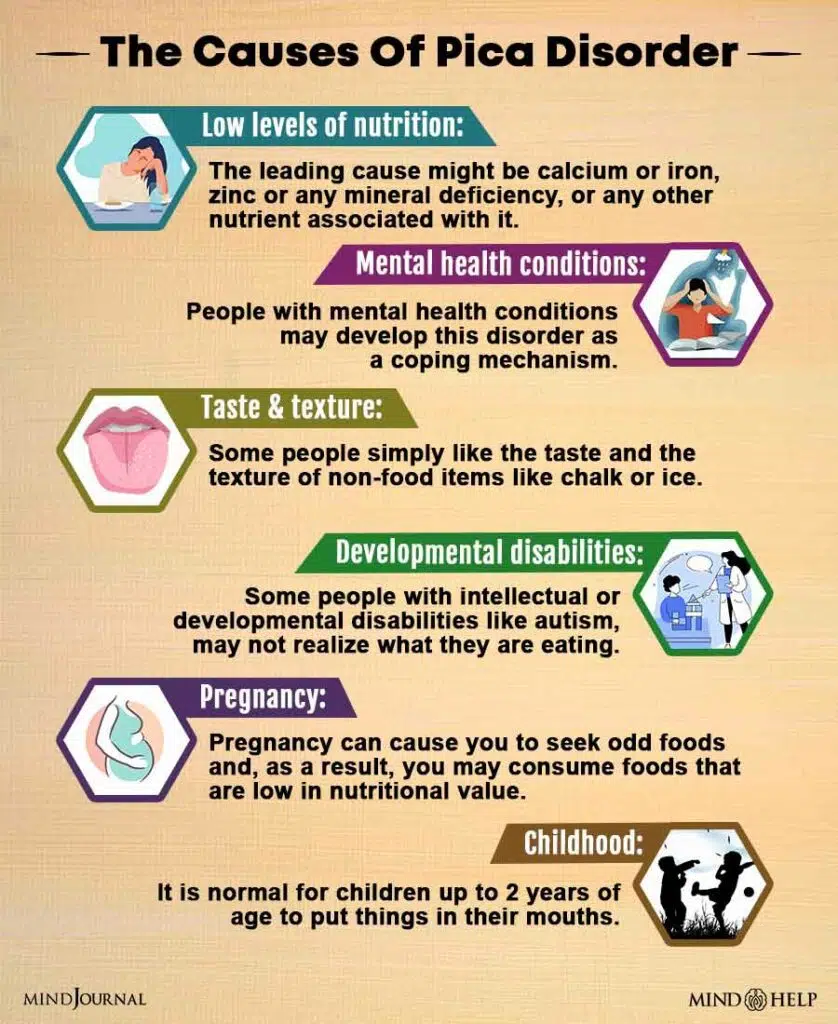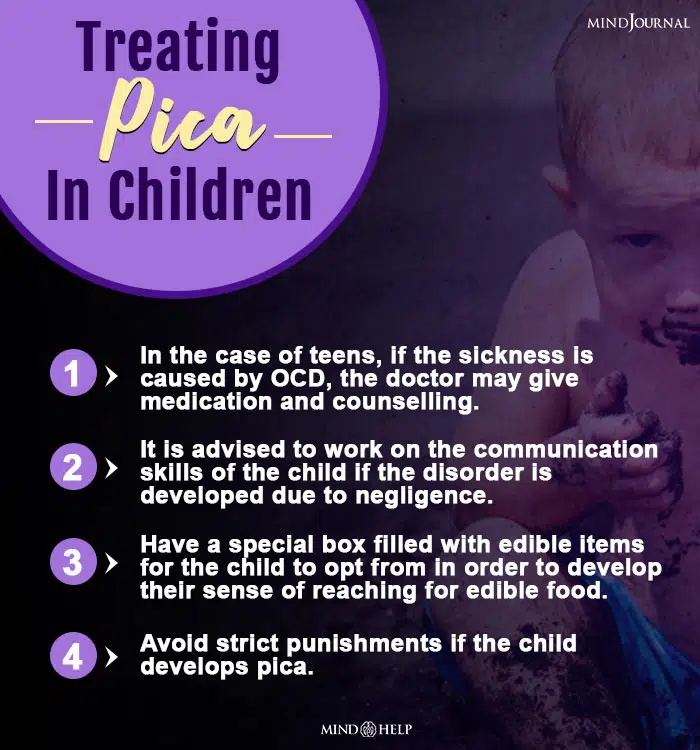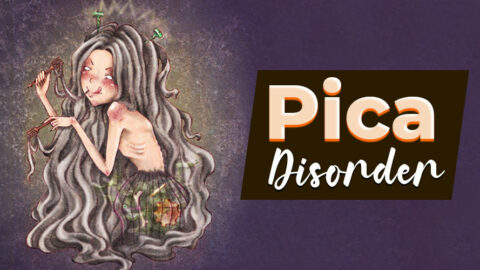Pica refers to the pathological and compulsive craving for and ingestion of non-nutritive or non-food items. It is a persistent mental disorder that is characterized by eating non-food items regularly.
What Is Pica Disorder?
Pica is a compulsive eating disorder where people eat items that have no nutritional value. According to a 2014 study 1 Advani, S., Kochhar, G., Chachra, S., & Dhawan, P. (2014). Eating everything except food (PICA): A rare case report and review. Journal of International Society of Preventive & Community Dentistry, 4(1), 1–4. https://doi.org/10.4103/2231-0762.127851 , pica is defined as “the act or habit of eating things that are not food”. An individual may eat harmless items like ice or potentially harmful items like flakes of dried paint or pieces of metal. It is repetitive non-nutritive ingestion that is developmentally inappropriate and occurs for at least a month. It can often result in certain health problems. People with this condition have an uncontrollable urge to consume things that can be harmful for them, like –
- Chalk
- Ice
- Dirt
- Paint flakes or drywall
- Clay
- Buttons
- Glass shards
- Hair
- Burnt matches
- Cigarette ashes
- Coins
- Soap
- Feces
This disorder is more common among children between the ages of 2 to 7, affecting around 10 to 30% of young children. They usually consume non-food items for the sole reason of being hungry. However, there may be a problem if a youngster has progressed above his or her developmental stage and suddenly begins to consume non-food substances.
One German prevalence study 2 Murray, H. B., Thomas, J. J., Hinz, A., Munsch, S., & Hilbert, A. (2018). Prevalence in primary school youth of pica and rumination behavior: The understudied feeding disorders. The International journal of eating disorders, 51(8), 994–998. https://doi.org/10.1002/eat.22898 revealed that 12.3% of primary school children exhibit symptoms of pica at some point in their lives. The disorder can even occur in children and adults with intellectual and developmental disabilities like autism. Pregnant women are also known to have cravings for non-food items. Studies 3 Fawcett, E. J., Fawcett, J. M., & Mazmanian, D. (2016). A meta-analysis of the worldwide prevalence of pica during pregnancy and the postpartum period. International journal of gynaecology and obstetrics: the official organ of the International Federation of Gynaecology and Obstetrics, 133(3), 277–283. https://doi.org/10.1016/j.ijgo.2015.10.012 reveal that around 27.8% of women experience pica during pregnancy. This may be related to any deficiency present in the body.
Understanding Pica Disorder
The word Pica is derived from the Latin term “pica-pica,” referring to the magpie bird. Magpies 4 Johnson, B. E. (1990). Pica. In H. K. Walker (Eds.) et. al., Clinical Methods: The History, Physical, and Laboratory Examinations. (3rd ed.). Butterworths. tend to incessantly collect and eat almost everything and can even ingest certain objects simply out of curiosity. As for the mental disorder, a person with this condition may eat variable items from earth (geophagy), ice (pagophagia), raw starches (amylophagy), to charcoal, baby powder, eggshells and coffee grounds. According to a recent 2020 scientific review 5 Al Nasser Y, Muco E, Alsaad AJ. Pica. [Updated 2021 Jul 29]. In: StatPearls [Internet]. Treasure Island (FL): StatPearls Publishing; 2021 Jan-. Available from: https://www.ncbi.nlm.nih.gov/books/NBK532242/ , pica may occur “as an isolated disorder but there are instances when it may coexist with schizophrenia, OCD, and trichotillomania.”
To diagnose this condition, the sufferer should be at least 2 years of age and must engage in eating non-nutritive items or raw food ingredients for at least a period of one month. This is important as younger children often tend to eat substances with no nutritional value out of curiosity. Furthermore, in some parts of the world, the consumption of such products and items may be culturally significant and acceptable. This is why, sociocultural, geographical, and developmental factors are considered while determining this eating disorder.
According to a report published in Psychiatric Times, pica may result in geophagia and lead intoxication in children. Moreover, it may adversely affect physical & intellectual development in sufferers, along with chronic and acute medical complications leading to surgical emergencies. If this illness is not addressed, it can lead to nutritional deficiencies, intoxication, and parasitosis. The report states “In the spectrum of eating disorders, pica may be viewed as a derailment of food selection and a driven, often chaotic, form of ingestive behavior.”
However, in most cases the condition is temporary. Moreover, proper treatment under the guidance of a medical doctor can help the sufferer overcome the disorder and recover from potential side effects.
Read More About Obsessive-Compulsive Disorder (OCD) Here
What Are The Signs And Symptoms?
Pica is characterized by the inability to stop eating non-food items for more than a month. Consumption of non-food items can be really harmful to the body. The individual consuming non-food items may experience some of the symptoms mentioned below:
- Stomach upset
- Stomach pain
- Blood in the stool (it may be a sign of an ulcer in the stomach from eating non-food items)
- Bowel problems (constipation or diarrhea)
What Are The Complications Associated With This Disorder?

According to a study conducted by the Healthcare Cost and Utilization Project (HCUP) Statistical Briefs, “hospitalizations for pica increased by 93 percent between 1999 and 2009”. Consumption of non-food things on a regular basis can be harmful to your health. It can lead to the following complications:
- Lead poisoning from excess consumption of paint flakes.
- Consumption of abrasive items such as rocks might cause intestinal obstruction or tear.
- Infections may damage the liver or kidneys.
- Infections caused by germs and parasites that enter the body after ingesting dirt or mud.
- Esophageal tears caused by sharp or harsh objects like metal scraps.
- Choking.
- Damage to the brain from eating lead or any other harmful substances.
- Constipation, bloody stool, or diarrhea.
- Iron-deficiency anemia.
- Mouth & teeth injuries.
- Developing ulcers
What Are The Causes Of Pica Disorder?

Currently, no single cause has been determined for this disorder. However, according to a 2014 study 6 Lumish, R. A., Young, S. L., Lee, S., Cooper, E., Pressman, E., Guillet, R., & O’Brien, K. O. (2014). Gestational iron deficiency is associated with pica behaviors in adolescents. The Journal of nutrition, 144(10), 1533–1539. https://doi.org/10.3945/jn.114.192070 , “the likely people to suffer from this disease are pregnant women, iron and zinc-deficient children, mentally retarded and malnourished children”.
There are several reasons why an individual may develop this disorder. Some of them are as follows:
1. Low levels of nutrition
The leading cause might be calcium or iron, zinc or any mineral deficiency, or any other nutrient associated with it. Any unexpected cravings could be a sign that your body is attempting to replenish any nutrients that have become depleted.
2. Mental health conditions
There are several mental health conditions associated with it. People with mental health conditions may develop this disorder as a coping mechanism. Some of them are as follows:
- Schizophrenia
- Obsessive-Compulsive Disorder
Read More About Schizophrenia Here
3. Taste & texture
Some people enjoy the flavor and texture of non-food things such as chalk or ice. It is also seen as acceptable behavior in some cultures. However, too much consumption may be detrimental to one’s health. This type of Pica Disorder is called geophagia.
4. Developmental disabilities
Some people with intellectual or developmental disabilities like autism, may not realize what they are eating. This may cause them to eat food items they are not supposed to.
5. Pregnancy
Pregnancy is one of the most common causes of eating disorders. Pregnancy can cause you to seek odd foods and, as a result, you may consume foods that are low in nutritional value. About 28 percent 7 Fawcett, E. J., Fawcett, J. M., & Mazmanian, D. (2016). A meta-analysis of the worldwide prevalence of pica during pregnancy and the postpartum period. International journal of gynaecology and obstetrics: the official organ of the International Federation of Gynaecology and Obstetrics, 133(3), 277–283. https://doi.org/10.1016/j.ijgo.2015.10.012 of women worldwide experience pica during pregnancy. It usually begins in the third trimester. According to research 8 Rainville A. J. (1998). Pica practices of pregnant women are associated with lower maternal hemoglobin level at delivery. Journal of the American Dietetic Association, 98(3), 293–296. https://doi.org/10.1016/S0002-8223(98)00069-8 on Pica in pregnant women, “Pica in pregnancy may be a result of iron deficiency.”
6. Childhood
It is normal for children up to 2 years of age to put things in their mouths. This behavior is considered normal since the child is only in the developmental stage of its life. It may be a concern when the child still feels the need to put non-food items in their mouth. For example, if the child is in school, he or she may eat non-food items like chalk or paper since it is easily accessible to the child.
This can happen as a result of a deficiency in calcium and nutrients. In some cases, it is also found that Pica is a direct suggestive of autism in children. Children are often found to develop this condition in order to get attention. However, it may also occur due to maternal negligence.
Read More About Childhood Here
How Can You Diagnose Pica?
There is no particular test to diagnose this disorder. Your doctor will evaluate your medical history, your current symptoms, and several other factors. It is important that you be honest with your doctor about all the non-food items you have eaten. This will allow your doctor to give a correct diagnosis and design your treatment plan.
Your doctor may even test your blood to check if there are any deficiencies in zinc or iron or any essential nutrients. This will enable the doctor to learn whether you have any underlying deficiency in your system.
The following criteria are used by healthcare providers to diagnose Pica:
- Duration of symptoms: The individual consuming food with non-nutritional value should do it persistently for at least a month.
- Cultural influence: There are certain cultures that promote consuming non-food substances. For example, Australian aborigines encourage young women to eat clay in order to be more fertile. However such practices have started to fade with the increased health education and access to medical care.
- Inappropriate behavior: It is common for young children to put non-food items in their month. This behavior is an essential part for children to develop their senses. This doesn’t mean that they have the disorder. However, after a certain age, this behavior is considered inappropriate as the child develops the idea of what to consume that has food value.
Treatment For Pica Disorder
People with Pica Disorder can have serious health complications, if not treated. They may experience intestinal blockage, infections, and other harmful effects that require immediate and specific medical attention. The consequences associated with the disorder has to be treated first in order to get to the root of the issue. The US National Library of Medicine states, ”treating PICA involves behaviors, the environment, and family education.”
1. Medications
Pica is generally treated by first attending the complications that have occurred from consuming non-food items. Like for example if you have any dental problems then your teeth would be treated first, or if you have acute lead poisoning your doctor may prescribe chelation therapy.
In this therapy, you are given medication that binds with the lead in your system allowing you to excrete the lead with your urine. If your doctor finds that you have nutrient deficiencies, they may prescribe vitamin or mineral supplements. For example, if you are anemic, your doctor can prescribe daily iron supplements to remove the deficiency from your body.
However, there are no specific medications designed particularly for the treatment of this disorder. Although antipsychotic drugs may reduce behaviors associated with pica, it may lead to adverse side effects.
2. Therapy
Sometimes psychological factors can contribute to the development of Pica. Your doctor may also recommend therapy, if he thinks that there is an underlying mental health condition that requires immediate attention. There are several methods that are adopted to treat patients. The most common is punishment or mild aversion therapy wherein the patient will have negative consequences or punishment for consuming non-food items. They may also get rewarded for eating normal food.
Some other treatment options include:
- Occupational therapy – It is used to help an individual regain independence in their lives. This therapy helps with the barriers that affect a person’s emotional, social, and physical needs.
- Sensory support – The patient is provided with a safer item to chew on.
In the case of pregnant women, this disorder generally goes away after the birth of the child. It should also be taken into account that you can delay the treatment in case of consumption of non-food items that are relatively harmless, like ice. Pica is also found to heal itself with age. However if left untreated, it can be detrimental to one’s health. It may even lead to hospitalization, if it gets serious.
Treating Pica In Children

The procedure for treating children is different since they are still in the growing stage of their life. Common treatment options for children suffering with this disorder are:
- In the case of teens, if the sickness is caused by OCD, the doctor may give medication and counselling.
- It is advised to work on the communication skills of the child if the disorder is developed due to negligence.
- Have a special box filled with edible items for the child to opt from in order to develop their sense of reaching for edible food.
- Avoid strict punishments if the child develops pica. Rather, use positive reinforcement by rewarding the youngster for consuming edible food.
How Can You Recover From Pica
Pica recovery is feasible if you consume all of the vitamins and nutrients your body requires and live a healthy lifestyle. Most children can naturally overcome pica as they become older. Most adults with this disorder are usually aware that the things that they are consuming are harmful. However, the desire to eat it can be overwhelming at times.
The right treatment can help you overcome this disorder whether it’s related to physical or psychological aspects of it. Your doctor can help a person overcome their cravings and return to their normal diet. It’s crucial to pay attention to the individual suffering from this condition and to know all the symptoms, causes, and treatment so that they can be protected from the harmful side effects of the disorder.
Pica Disorder At A Glance
- Pica is an eating disorder where people eat items that have no nutritional value.
- This disorder is more common among children between the ages of 2 to 7, affecting around 10 to 30% of young children.
- Pica is characterised by the inability to stop eating non-food items for more than a month.
- People with Pica Disorder can have serious health complications, if not treated.
- Pica recovery is feasible if you consume all of the vitamins and nutrients your body requires and live a healthy lifestyle.











